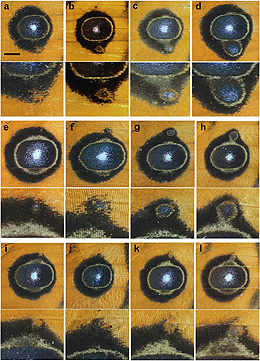Research Abstract
チョウの翅の色模様に対する人為的な変化の誘導:眼状紋の発生における動的なシグナルの相互作用
Artificially induced changes of butterfly wing colour patterns: dynamic signal interactions in eyespot development
2011年10月10日 Scientific Reports 1 : 111 doi: 10.1038/srep00111

チョウの翅の眼状紋の形成は、濃度勾配モデルで説明されてきた。しかし近年、このモデルに疑義が唱えられ、黒を誘導するシグナルとそれを阻害するシグナルとの動的な相互作用が提唱されている。今回、こうしたモデルの妥当性に関して、タテハチョウの一種であるタテハモドキ(Junonia almana)を用いて検討した。大きな眼状紋の焦点を早期に損傷させると、眼状紋は縮小する場合が多かったが、遅れて損傷させると、1つの眼状紋の外輪が拡大して内輪が縮小した。焦点を外して外輪に損傷を与えると、眼状紋全体の構造が損傷部位に引き寄せられたばかりでなく、眼状紋全体が縮小した。意外にも、大きな眼状紋の縮小は、付随する小型の眼状紋の拡大を伴った。こうした結果は、従来の勾配モデルの限界を明らかにするとともに、チョウの翅の色模様決定に関する形態シグナルが動的に相互作用する性質を支持している。
- 琉球大学理学部
Eyespot formation in butterfly wings has been explained by the concentration gradient model. However, this model has recently been questioned, and dynamic interactions between the black-inducing signal and its inhibitory signal have been proposed. Here, the validity of these models was examined using a nymphalid butterfly Junonia almana. Early focal damage to the major eyespots often made them smaller, whereas the late damage made the outer ring larger and the inner ring smaller in a single eyespot. Non-focal damage at the outer ring not only attracted the whole eyespot structure toward the damaged site but also reduced the overall size of the eyespot. Surprisingly, a reduction of the major eyespot was accompanied by an enlargement of the associated miniature eyespots. These results demonstrate limitations of the conventional gradient model and support a dynamic interactive nature of morphogenic signals for colour-pattern determination in butterfly wings.

